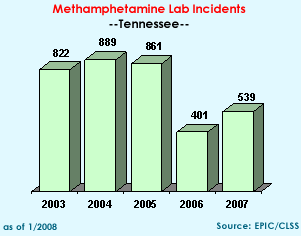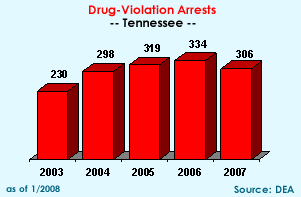|
DEA
Offices & Telephone Nos.
Chattanooga—423-855-6600
Johnson City—423-854-9100
Knoxville—865-584-9364
Memphis—901-544-3396
Nashville—615-736-5988 |
State Facts
Population: 5,962,959
State Prison Population: 25,884
Probation Population: 47,392
Violent Crime Rate
National Ranking: 4 |
2007
Federal Drug Seizures
Cocaine: 378.4 kgs.
Heroin: 19.3 kgs.
Methamphetamine: 7.0 kgs.
Marijuana: 5,135.3 kgs.
Hashish: 0.0 kgs.
MDMA: 0.1 kgs./57,215 du
Meth
Lab Incidents: 539
(DEA, state, and local) |
Drug
Situation: Geographically, Tennessee is unique because it is bordered by eight other states. The interstate and state highway systems crisscross Tennessee's four major cities and traverse each of its borders. These highways carry a very large volume of traffic and are a primary means of moving drugs to and through Tennessee. As a result, the drug situations in the neighboring states have an impact on the drug trafficking, availability, and abuse in Tennessee. Tennessee is predominantly a "user" and transshipment state, not a major source area for any drug except domestically grown marijuana.
 Cocaine:
Cocaine is usually transported to Tennessee in multi-kilogram quantities from cities in the western United States and from Texas, Illinois, Georgia, and California. Hamilton, Davidson, and Shelby counties are considered the distribution hubs for the state. Abusers of cocaine in Tennessee tend to consume the drug as crack - a change from powdered cocaine HCl abuse of a few years ago, currently making crack the most popular drug of abuse among Tennessee residents. Tennessee has remained an area of choice for the illicit activities of structured Mexican drug trafficking organizations. These structured groups respond to command and control elements in Atlanta, Los Angeles, Houston, El Paso, and Mexico. Cocaine:
Cocaine is usually transported to Tennessee in multi-kilogram quantities from cities in the western United States and from Texas, Illinois, Georgia, and California. Hamilton, Davidson, and Shelby counties are considered the distribution hubs for the state. Abusers of cocaine in Tennessee tend to consume the drug as crack - a change from powdered cocaine HCl abuse of a few years ago, currently making crack the most popular drug of abuse among Tennessee residents. Tennessee has remained an area of choice for the illicit activities of structured Mexican drug trafficking organizations. These structured groups respond to command and control elements in Atlanta, Los Angeles, Houston, El Paso, and Mexico.
 Heroin: Heroin use in Tennessee is limited to a very small number of long-time users. The heroin trafficking situation has been very stable in the state for the past six years, though an increase in heroin availability and highway interdiction was reported recently; however, no great change in the demand for the drug is indicated by other factors in Tennessee. Texas, Georgia, and New York are the main sources of Mexican Black Tar, Mexican brown, and Southwest Asian heroin in Tennessee. Heroin: Heroin use in Tennessee is limited to a very small number of long-time users. The heroin trafficking situation has been very stable in the state for the past six years, though an increase in heroin availability and highway interdiction was reported recently; however, no great change in the demand for the drug is indicated by other factors in Tennessee. Texas, Georgia, and New York are the main sources of Mexican Black Tar, Mexican brown, and Southwest Asian heroin in Tennessee.
  Methamphetamine: The availability and demand for methamphetamine continues to increase throughout Tennessee. Much of the methamphetamine consumed in the state is transported from Mexico and the Southwest Border states. Clandestine methamphetamine labs can be found everywhere in Tennessee, but are predominantly located in the Appalachian areas in Eastern Tennessee. These labs are encountered less and less frequently by law enforcement. The number of lab seizures has decreased significantly since legislation in 2005 was passed to restrict the availability of necessary ingredients for the processing of methamphetamine. The labs that are discovered in Tennessee are generally characterized as small and unsophisticated. These clandestine methamphetamine labs continue to pose a significant threat because lab operators are frequently armed and substantially involved in the drug's distribution and therefore tend to place booby traps around the sites. Southeast Tennessee has seen a significant increase in the activities of structured Mexican methamphetamine trafficking groups. These groups control much of the methamphetamine distribution in the Chattanooga area, but command and control for these Mexican organizations are frequently found in Dalton, Georgia. An increase in methamphetamine use and abuse is anticipated in Tennessee as the drug gains popularity over crack cocaine use. Methamphetamine: The availability and demand for methamphetamine continues to increase throughout Tennessee. Much of the methamphetamine consumed in the state is transported from Mexico and the Southwest Border states. Clandestine methamphetamine labs can be found everywhere in Tennessee, but are predominantly located in the Appalachian areas in Eastern Tennessee. These labs are encountered less and less frequently by law enforcement. The number of lab seizures has decreased significantly since legislation in 2005 was passed to restrict the availability of necessary ingredients for the processing of methamphetamine. The labs that are discovered in Tennessee are generally characterized as small and unsophisticated. These clandestine methamphetamine labs continue to pose a significant threat because lab operators are frequently armed and substantially involved in the drug's distribution and therefore tend to place booby traps around the sites. Southeast Tennessee has seen a significant increase in the activities of structured Mexican methamphetamine trafficking groups. These groups control much of the methamphetamine distribution in the Chattanooga area, but command and control for these Mexican organizations are frequently found in Dalton, Georgia. An increase in methamphetamine use and abuse is anticipated in Tennessee as the drug gains popularity over crack cocaine use.
 Club
Drugs: Tennessee has a growing “Club Drugs” problem, with MDMA (Ecstasy), LSD, and GHB being the most common drugs of abuse. These drugs are frequently sold at “Rave” dance parties and nightclubs and have been predominantly seen in the cities of Nashville and Knoxville. Club
Drugs: Tennessee has a growing “Club Drugs” problem, with MDMA (Ecstasy), LSD, and GHB being the most common drugs of abuse. These drugs are frequently sold at “Rave” dance parties and nightclubs and have been predominantly seen in the cities of Nashville and Knoxville.
 Marijuana:
Marijuana abuse and trafficking is a serious problem throughout the state, especially in rural areas. Tennessee is a major supplier of domestically grown marijuana, although Mexican marijuana has also been seized by Tennessee law enforcement officials. In fact, according to the Appalachia HIDTA Threat Assessment, Tennessee, along with West Virginia and Kentucky, produce the majority of the United States' supply of domestic marijuana. Prosecution of marijuana growers in the state has been extremely difficult. Many of the marijuana sites detected in the state are so small that even if the owner/grower were identified, the U.S. Attorney would be reluctant to prosecute. In certain areas of the state, marijuana is favored over other drugs of abuse by some individuals. Marijuana:
Marijuana abuse and trafficking is a serious problem throughout the state, especially in rural areas. Tennessee is a major supplier of domestically grown marijuana, although Mexican marijuana has also been seized by Tennessee law enforcement officials. In fact, according to the Appalachia HIDTA Threat Assessment, Tennessee, along with West Virginia and Kentucky, produce the majority of the United States' supply of domestic marijuana. Prosecution of marijuana growers in the state has been extremely difficult. Many of the marijuana sites detected in the state are so small that even if the owner/grower were identified, the U.S. Attorney would be reluctant to prosecute. In certain areas of the state, marijuana is favored over other drugs of abuse by some individuals.
  Other
Drugs: Distribution of Ecstasy (MDMA) and LSD is on the rise, especially in and around the college campuses in Nashville. These Club Drugs are abused primarily at "Rave" parties and nightclubs and are transported into the area from New York, Georgia, and Florida. Diverted pharmaceuticals pose a growing problem in Tennessee where the state health care program is utilized by abusers to “doctor shop” without paying for medical care. A special ARCOS report prepared for the Tennessee Medical Board showed that consumption of hydromorphone, hydrocodone, meperidine, and amphetamine was above average in the state. Dilaudid and morphine are also mentioned as heavily abused drugs in Tennessee. Other
Drugs: Distribution of Ecstasy (MDMA) and LSD is on the rise, especially in and around the college campuses in Nashville. These Club Drugs are abused primarily at "Rave" parties and nightclubs and are transported into the area from New York, Georgia, and Florida. Diverted pharmaceuticals pose a growing problem in Tennessee where the state health care program is utilized by abusers to “doctor shop” without paying for medical care. A special ARCOS report prepared for the Tennessee Medical Board showed that consumption of hydromorphone, hydrocodone, meperidine, and amphetamine was above average in the state. Dilaudid and morphine are also mentioned as heavily abused drugs in Tennessee.
Pharmaceutical Diversion: Current investigations indicate that diversion of hydrocodone products and pseudoephedrine/ephedrine continues to be a problem in Tennessee even though the state passed and signed into law the “Meth-Free Tennessee Act of 2005” in March 2005. This law limited the sale of the pseudoephedrine-containing products that meth cooks rely on for the production of methamphetamine, closed a loophole that allowed for personal use of methamphetamine, and required healthcare professionals to report meth lab-related burns and injuries to law enforcement. Primary methods of diversion being reported are illegal sale and distribution by health care professionals and workers, “doctor shopping” (going to a number of doctors to obtain prescriptions for a controlled pharmaceutical) through the state health care program, the Internet, and forged prescriptions. OxyContin®, methadone, morphine, and Xanax® were identified as being among the most commonly abused and diverted pharmaceuticals in Tennessee.
 DEA
Mobile Enforcement Teams: This cooperative program with state
and local law enforcement counterparts was conceived in 1995 in response
to the overwhelming problem of drug-related violent crime in towns and
cities across the nation. Since the inception of the MET Program, 473
deployments have been completed nationwide, resulting in 19,643 arrests.
There have been two MET deployments in the State of Tennessee since the
inception of the program, in Chattanooga and Clarksville. DEA
Mobile Enforcement Teams: This cooperative program with state
and local law enforcement counterparts was conceived in 1995 in response
to the overwhelming problem of drug-related violent crime in towns and
cities across the nation. Since the inception of the MET Program, 473
deployments have been completed nationwide, resulting in 19,643 arrests.
There have been two MET deployments in the State of Tennessee since the
inception of the program, in Chattanooga and Clarksville.
DEA
Regional Enforcement Teams:
This program was designed to augment existing DEA division resources
by targeting drug organizations operating in the United States where
there is a lack of sufficient local drug law enforcement. This program
was conceived in 1999 in response to the threat posed by drug trafficking
organizations that have established networks of cells to conduct drug
trafficking operations in smaller, non-traditional trafficking locations
in the United States. As of January 31, 2005, there have been 27 deployments
nationwide, and one deployment in the U.S. Virgin Islands, resulting
in 671 arrests. There have been no RET deployments in the State of Tennessee.
More information
about the Atlanta Division Office.
Sources
Factsheet
last updated:
3/2008
Click
here for last year's factsheet >>
|

